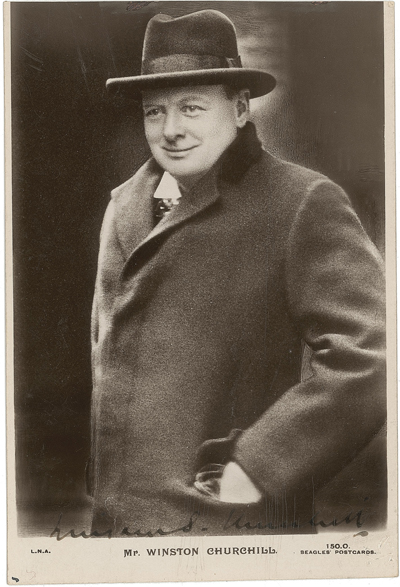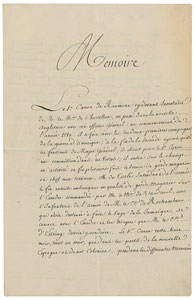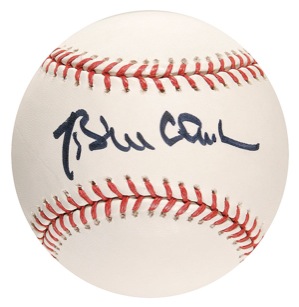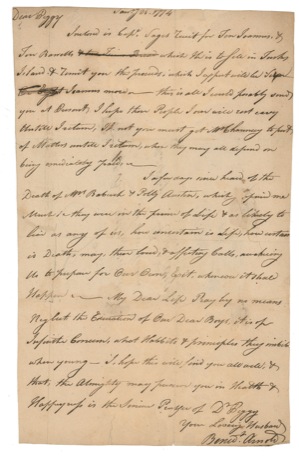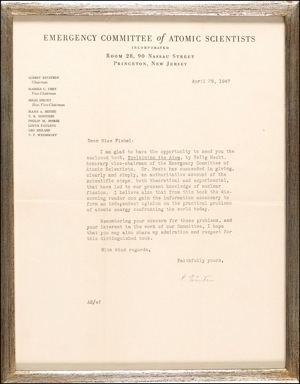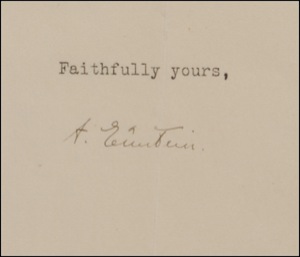

Present is a photocopy of an Affidavit and Deed of Gift signed in full and dated 16 August 1977 by Abraham Lincoln’s great grandson and last direct descendant, Robert Todd Lincoln Beckwith (1904-1985): In full, “I, Robert Todd Lincoln Beckwith of Washington, D.C., certify that among the contents of a trunk located and unopened until recently, and placed in the attic of Hildene, the estate of my grandfather Robert Todd Lincoln, Manchester, Vermont, by my grandmother Mary Harlan Lincoln (Mrs. Robert Todd Lincoln), and the said contents being awarded to me by the Estate of my sister Mary Lincoln Beckwith, were found two pair of eye glasses which had belonged to my great grandfather President Abraham Lincoln, and so marked by my grandmother Mary Harlan Lincoln. I further give one pair of these eye glasses to Margaret Fristoe of Chevy Chase, Maryland, and one pair to James T. Hickey of Elkhart, Illinois.” At the time, Hickey was the Curator of the Lincoln Collection of the Illinois State Historical Library, now the Abraham Lincoln Presidential Library. The pair given to Hickey is in the Library’s collection. Abraham Lincoln’s son, Robert Todd Lincoln, married Mary Harlan. Their daughter Jessie Lincoln married Warren Wallace Beckwith. Jessie and Warren’s son, Robert Todd Lincoln Beckwith, married Mrs. Margaret Fristoe (1921-2009) in 1979. Her sole heir was her daughter, Lenora Fristoe Hoverson, Robert Beckwith’s stepdaughter. Her affidavit is also present. Two pair of eyeglasses, both in the trunk at Hildene, among other artifacts, were consigned by Mrs. Hoverson to a reputable mid-west entity and were purchased by University Archives.
In 1937, a locked leather box containing the contents of Lincoln’s pockets the night of his assassination in 1865 was donated by the family to the Library of Congress. Included were two pairs of spectacles and their cases. In 1977, the prescriptions for both pairs were examined by the Chief Optician for the Veteran’s Administration. One pair was corrected to +1.75, the other +2.00. The photographs of Abraham Lincoln referred to below are identified by the numbers assigned to them by Lloyd Ostendorf in Lincoln in Photographs: An Album of Every Known Pose by Charles Hamilton and Lloyd Ostendorf (Norman, Oklahoma: University of Oklahoma Press, 1963). The gold colored pair here offered appear to be the spectacles Lincoln is holding in his hands in a photograph made by Alexander Gardner in Washington, D.C., between early February and April 10, 1865 (O-116D), one of a multi-image stereographic pose of four images. Charles Hamilton writes, ‘The President holds his spectacles and a pencil, both blurred, showing that he moved his fingers nervously during the exposure...When the camera failed to record some fascinating or intimate detail, the photographer often employed an artist to retouch or add to the scene. Here Lincoln’s spectacles and pencil, blurred in the original negative, are plainly outlined’ –undoubtedly using the spectacles worn by Lincoln as a model. Numerous books, including Mellon’s The Face of Lincoln reproduce this photograph clearly showing him holding his spectacles . The shape of the lenses of the gold colored pair are identical to those in the photograph (O-116D). The hinge connecting the lens to the temple which loops around the ear has a visible split in the photograph and in the gold colored spectacles. The thin wire temple loop of the gold colored spectacles are clearly visible in the photograph. The catalogue description of these spectacles stated that the gold colored pair (identified in the catalogue as “brass”) had ‘a prescription for +2.75’ and because this strength far exceed the strongest pair found in Lincoln’s pocket (+2.00), this pair could not have been worn by Lincoln. Because of the extraordinary similarity of the spectacles in Lincoln’s hands and the gold colored pair purchased by University Archives, these spectacles were brought to Frank Gyure, American Board of Opticianry Certified and Fellow, National Association of Opticians, who carefully inspected them. The result of his examination is present. In part, ‘The lenses were inspected by a device known simultaneously as a lensometer, focimeter, lensmeter. This device is used to measure the dioptric power of spectacle lenses. The dioptre is the most common unit of measurement of optical power. The device which was used to inspect the presented spectacles was made by the Marco Corporation, a leading manufacturer of optical instruments. It is in good working order to the best of my knowledge ... The spectacle labeled as gold in color had the following Power; +2.12 OD(Right Eye), +2.12 OS(Left Eye)...’ Lincoln had with him two pair of spectacles at the time of his death. One pair was a gift from a lawyer who rode the circuit with Lincoln and was appointed a Washington city marshal by President Lincoln. A temple is inscribed ‘A. Lincoln, presented by Ward H. Lamon.’ This pair was corrected to +2.00. The spectacles here offered is +2.12. It is reasonable to assume that these were not his only spectacles and that the President had others at the Executive Mansion. Ostensibly, Lincoln used different spectacles to read newspapers, books, and letters, so he carried with him more than one pair. Spectacles manufactured in the 19th century varied widely in workmanship, materials and design. In many cases, prescriptions were not made to order, such as the pair Lamon bought. Spectacles were sold by traveling peddlers, at the jewelry shops (where Lincoln bought his first pair), or in general stores. President Lincoln is wearing his spectacles in the famous photograph of Lincoln and his son Tad looking through a photograph album (O-93). It was taken by Anthony Berger at Mathew Brady’s Washington gallery on February 9, 1864. This is the only known close-up photograph of Lincoln wearing spectacles. On November 19, 2008, at Heritage Auctions, a pair of spectacles belonging to Abraham Lincoln sold for $179,250. Accompanying the spectacles were a letter from Mary Harlan Lincoln (Mrs. Robert Todd Lincoln) to Joseph Leisenring presenting him with a book owned by her late son, Abraham Lincoln II, saying, ‘You can put it away with the ‘A.L.’ spectacles which I gave you a long time ago & so have a little memento of the grand-son as well as the grand-father’ and a 1985 affidavit signed by David Rowland, Leisenring’s great-great grandson, setting out the chain of family ownership until their acquisition by Dr. Joseph Lattimer, the consignor of the spectacles. The strength of the lenses of these spectacles was not mentioned in the description suggesting the power was never determined. Those spectacles, as were the gold colored spectacles here offered, originated from Mrs. Robert Todd Lincoln. With President Lincoln’s daughter-in-law being the source of both pairs, the major difference between the Lattimer spectacles and these gold colored spectacles is that all evidence points to these gold colored spectacles being the ones President Lincoln is holding in the photograph taken in early 1865 by Alexander Gardner in Washington, D.C. (O-116D). RRAuction COA.
http://rrauction.com/bidtracker_detail.cfm?IN=1582







